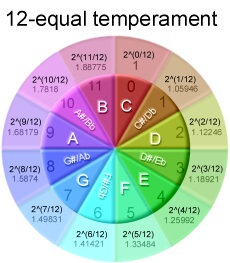« Literary Mission |
Main
| Moving Forward; Melodic Progression »
 April 22, 2010 | Frets and temperament April 22, 2010 | Frets and temperament
 Have you ever been scowled at by an orchestral musician for using an electronic tuner? If so, there's a reason that has nothing to do with the ear, but with tradition and the theories of acoustics. The study of equal temperament is much more intriguing than one might suspect, with literal centuries of debate over how to determine exactly "on pitch" is. Have you ever been scowled at by an orchestral musician for using an electronic tuner? If so, there's a reason that has nothing to do with the ear, but with tradition and the theories of acoustics. The study of equal temperament is much more intriguing than one might suspect, with literal centuries of debate over how to determine exactly "on pitch" is.
There's a fascinating article by Slate author Jan Swafford you'll want to read, "The Wolf at Our Heels," about the eternal struggle to play in tune. You'll want to take some time to read this, as it goes into the details of the theory, and more interesting, the social struggles that accompany the "mathematics" of music, and as is all to common, the relativistic aesthetic struggles of right and wrong. Musically.
In essence, the way our scale is laid out linearly is not in perfect compatibility with the vertical (chords), especially when you start migrating tonal centers. For example, a when Perfect 5th of an A and an E is sounded, the same A when used as the 5th of D is mathematically off. Not much, but it's still off though not detected by most ears. However, when you start migrating around the Circle of Fifths, let alone modulate tonal centers in a Broadway song, the variation can be a aurally detectable problem.
Tuning is relative, and in the case of a violin, trombone, or voice, pitch can be instantly adjusted for perfect and exact intonation. You don't have this adjustability in fretted instruments, or keyboard based like piano or xylophone. The only solution is compromise, and the most commonly accepted practice is what's called Equal Temperament.

From the article: "One of those tunings was already known to the ancients: equal temperament. Here the poison is distributed equally through the system: The distance between each interval is mathematically the same, so each interval is equally in, and slightly out of, tune. Nothing is perfect; nothing is terrible. So now it's all fixed, yes? The laughter of the gods has been stilled, right? Are you kidding? You fools: The gods never lose."
Why should this matter? When an orchestra gathers, you have instruments that can adjust playing along with those who can't. Compromise is still a necessity, although slow, exposed sections of instruments may very well be adapted. If you play with a fiddle, cut them some slack when they are tuning their instruments; they are fighting an entirely different intonation battle than those with frets.
Meantime (pun intended), don't throw away your tuner...
Read article: The Wolf at Our Heels
Posted by Ted at April 22, 2010 8:49 AM

Disclaimer: In the 'Information Age' of the 21st Century,
any fool with a computer, a modem, and an idea can
become a self-professed 'expert." This site does not
come equipped with 'discernment.'
|



